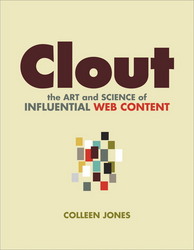
Book cover for Clout: the Art and Science of Influential Web Content, published by New Riders.
As far as user experience designers are concerned, 2010 can be easily summed up in two words: Content Strategy. Never before has such a relatively new discipline received such widespread press. Sure, if you were one of those designers “in the know,” you’ve probably read an article or two about Content Strategy on A List Apart. But the rest of the world didn’t have a clue…until now.
Today, companies of all sizes don’t just mention Content Strategy, they’re starting to practice it! Content is all the rage—and the pervasive question? “How do we create content that users will care about and act on?”
Fortunately, one content strategist has the answer. Colleen Jones is the principal of the Atlanta-based firm, Content Science. Leveraging over a decade of experience, Colleen helps her clients figure out, first, how to prepare their digital content strategy and, second, how to make their content work for them. In other words, she helps her clients attain clout.
In her new book, Clout: The Art and Science of Content, Colleen shares her most sagacious advice in just over 200 pages. How she did it, I just don’t know. In this interview, I dig in deep: asking Colleen questions about her new book, her prior consulting experience, and what her forthcoming clout means for the future of Content Science.
- Hey Colleen! Thanks so much for taking part in an interview for UX Booth readers. To start, could you tell us a bit about yourself, including your role as the owner of Content Science?
- It’s a pleasure! I’ve been tackling content and UX challenges for 13 years, now. After long stints at Centers for Disease Control and Prevention (CDC) and Cingular Wireless, I began contracting on my own. In early 2010, I started Content Science. We work with many of the corporate headquarters, niche brands, and government agencies here. Atlanta has quite a few startups, too, and we advise them about the UX of their digital products.
- That might sound like a very diverse background, but I’ve found the variety to be really, really helpful. I know what it’s like to be on the “client side” and have to live with content, technology, and design decisions for a long time, not just a project. I also have learned how to understand context, or the situation, quickly. I’ve worked on websites, IVRs, mobile devices, applications, kiosks, and just about anything interactive. And, I know first hand what it’s like to balance organizational goals, many stakeholders, and user needs. Throughout it all, I’ve made some mistakes and had some successes. So, I share my best lessons learned about content in Clout.
- I imagine that writing an entire book about Clout was a very difficult process. Most notably because my experience with the web points to a meritocracy: the more positive work you do, be bigger your reputation – your clout – becomes. Yet this approach is, like most things of substance, easier said than done. How did you determine which characteristics inspire clout in today’s audiences and, more importantly, the crucial steps in which content novices could go about attaining it?
- You’re right, it was difficult. I worked very hard to make the book easy to read but also meaningful and thought-provoking. I think people hear some confusing advice about influencing online. My goal was to end the confusion with advice grounded in solid principles. I included insights from my experience and principles of rhetoric as well as psychology. I also talked to persuasive design expert B.J. Fogg of Stanford University, who graciously let me reference his work on influencing behavior.
- I think it’s interesting—and, at times, frustrating—that clout is not only about the positive work you do. As a simple example, you can create awesome content or an awesome product, but if no one knows about it, your organization will not achieve clout. So, awareness is very important. But, how do you make people aware of your awesome work without annoying them? It’s tough, but Clout offers principles to help.
- And, in a survey I conducted early on about the book, I knew that readers wanted examples and case studies. So, I spent much time talking to people with all kinds of organizations such as Newell Rubbermaid, North Carolina State University, WhiteHouse.gov, Grasshopper, HowStuffWorks.com, and more to help show those crucial steps. The result is Clout has more than 150 examples and case studies.
- Indeed, I found it difficult to put the book down! But, now, I’m curious: out of those 150 examples, what are the takeaways? What elements of content strategy constitute a “working knowledge” for today’s internet professionals? Creating any sufficiently complex website require close collaboration between a group of professionals. As a consequence, any particular team member needs to understand how their work relates to the website as a whole, including its content strategy. So what’s the foundation?
- You make a great point about collaboration. I would say that three elements of content strategy are essential: analysis, editorial, and architecture. You need analysis to understand your content and your situation, or context. That’s what drives your strategy. Then, you need editorial to turn analysis into ideas, calendars, workflow, and quality content. You also need architecture to plan how your content is structured, how it’s displayed, and where it will be delivered, such as a website and mobile devices. Then, you need analysis again to decide whether you’re getting results. If not, then you need to adjust editorial and architecture.
- Much of the advice you give in the book is especially valuable to those who are new to the web in terms of content creation. Did you write this book especially for these people (bloggers, content creators at startups, etc.)? Most beginners haven’t heard of a content audit or a style guide. I ask this question because – back when I lived in Atlanta and attended the local Blogger meetup – conversations about blogging inevitably tended towards what would otherwise be described as content strategy and clout.
- Clout has layers, like an onion. If you’re new and want only basics, you can peel those off easily. For example, if you’re deciding whether to spend money on SEO tricks or better content, you’ll learn I think you should spend it on better content and why. If you’re more experienced and want to dig into deeper topics, you can. For example, the idea of WhiteHouse.gov as an influential media property raises some interesting questions about freedom of the press. The book mentions them but doesn’t make you analyze them in painful detail. I promise that Clout doesn’t make you cry like an onion can.
- Also, Clout can help people who you might consider to be content experts, such as journalists or technical communicators. The book shows how their talents are needed in surprising new areas. In a way, I hope this book gives them some deserved career juice as content strategists.
- Finally: now that your book is complete, what are your future plans for attaining and sharing clout with a broader audience? Writing this book certainly brings clout to your consultancy. Have you considered lending it to any of the ailing parties you mention in your book? For example: the ad industry or the health industry?
- For the health industry, I just learned that CDC ordered Clout for training. That’s a very encouraging start.I’m hopeful for the advertising industry because many advertisers and publishers seem ready for a change. Those parties need to speak more, but I’ll help move the conversation forward. Also, Peter Merholz and Karen McGrane have sparked interesting discussion about how UX fits into all this. I added my two cents in a recent blog post.
For the technology, design, and marketing communities, I’m reaching out in 2011 more than I ever have. For example, Tim Jones of North Carolina State University and I are speaking at the O’Reilly Where 2.0 conference about content and location-based services (LBS). Most talk about LBS is social and technology, and we’re going to bring content into the discussion. Wish us luck!
Realistically, it will take more than a book—and many more people than me—to create lasting change in these industries. But, I’m doing all I can to be a catalyst and won’t stop anytime soon. I’m excited about the growing content strategy community around the world, too. It’s bustling with talent, ideas, and accomplishments. Count on hearing and seeing much more from this community in 2011!
Closing thoughts
Thanks again, Colleen, for taking the time to share your thoughts with our readers. If you’ve got questions for Colleen, feel free to ask them in the comments below!
About the book

Results. Everyone wants them, whether to sell more products, spread good ideas, or win more funding. In our busy digital world, the way to results is influencing people on the web. But how? An ad campaign won’t cut it. A Twitter account doesn’t guarantee it. Manipulative tricks will backfire. Instead, you need quality, compelling web content that attracts people and engages them for the long haul. Clout explains the key principles of influence and how to apply them to web content.
About our Guest
Colleen Jones

A veteran of the interactive industry, Colleen has guided or supported strategic initiatives for global brands, government agencies, boutique brands, and savvy startups. She has presented about content strategy, user experience, and interactive marketing around the world. Colleen is Principal of Content Science, a content strategy and UX consultancy and can be found at @leenjones on Twitter.